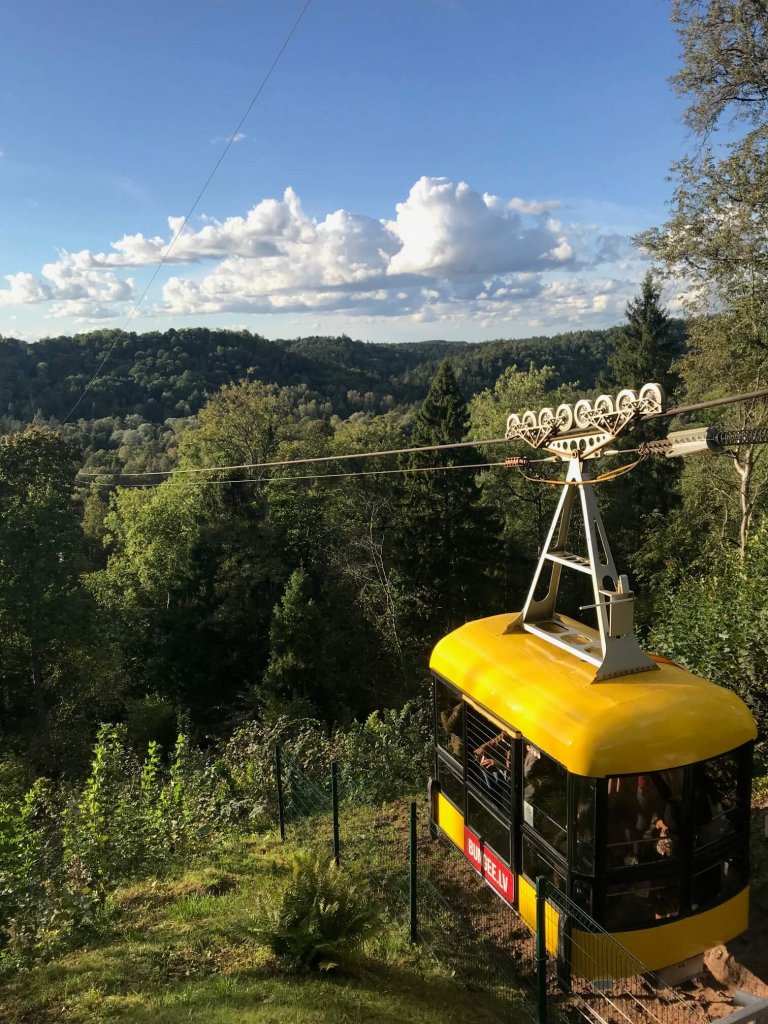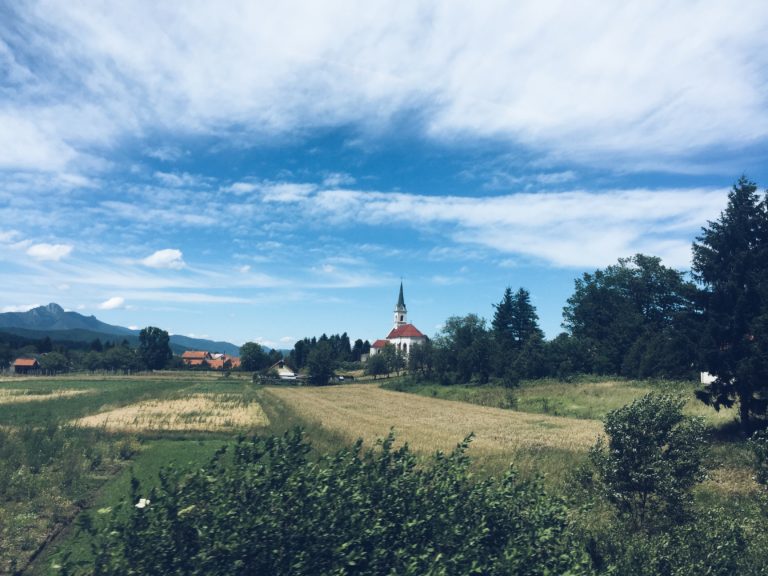24 Hours in Sigulda, the ‘Switzerland of Latvia’
If you’re planning a trip to Latvia and looking for a perfect day trip from Riga, do make some time in your itinerary to checkout the beautiful Sigulda. Ruined medieval castles, picturesque landscapes, historical and cultural monuments spanning several centuries, tons of adrenaline bursting adventure activities that range from ziplining and hiking to horseback riding and canoeing-there’s a ton of exciting things to do in Sigulda. Add to that a burgeoning gastronomic scene that saw the Riga-Gauja region become the European Centre of Gastronomy in 2017 plus the opportunity to stay in a range of excellent and extremely budget friendly places and you have all the ingredients of a wonderful few days. Here’s my Sigulda city guide and an outline of what you can expect if you are planning a daytrip to Sigulda.
1.Sigulda Castle Ruins and the New Castle
One of the key highlights of any trip to Sigulda is visiting its medieval castle which was built in 1207 by the Livonian Order, a military order of monks. Today the old castle lies in ruin although several efforts to reconstruct it to its former grandeur have been attempted. In 2011 the European Union helped to fund the reconstruction of the castle ruins resulting in the possibility to presently climb up the Castle’s southern and northern towers. The castle plays host to several annual open-air concerts and festivals during the year with the castle ruins as backdrop.
Top Tip: One of the highlights of visiting the castle is paying a visit to the castle stables where you can book a creative workshop and learn everything from pottery to leather making, Baltic jewellery and also make the famous walking sticks which are symbol of the area. Pop into Siguldas saldejums to sample their homemade ice-cream and delicious waffles.
2. Walking Stick Park
The Walking Stick Park was established in 2007 as a tribute to the age-old art of stick making that is popular to this region. Cane-making has a 200 year old history in Sigulda. The walking sticks originally had a utilitarian purpose, given the nature of the undulating local terrain but have gradually morphed into a beautiful art form. You’ll find the Walking Stick Park at the intersection of Poruka and Cesa streets where you’re greeted by a vivid array of brightly coloured walking sticks. The sticks are made from a variety of trees including hazelnut, cherry, juniper, willow and others. After an intense process of steaming, bending and drying, the sticks are painted and varnished to perfection.
3. Museum Reserve and Medieval Castle of Turaida
Another iconic landmark that stands out in the leafy deeply forested area of Sigulda is the imposing turret of the red brick castle, Turaida.
The Castle was made to resemble a mighty ship with the northern forecastle tower being the front part of the ship, the lofty main tower being the spar of the tallest part of the ship and the southern tower forming the ship’s rear.
Having survived decay and destruction over the ages, it has been recently loving reconstructed to former glory.
Hop to the top of the viewing platform of the Castle’s northern tower to obtain a bird’s eye view of the pretty Gauja Valley and the rest of the Museum Reserve, a large area which is dedicated to the preservation of some key sites and buildings of great archaeological and historical importance. These include the Turaida Stone Castle, a Folk Song Garden, a Folk Song Hill, the Rose of Turaida Memorial and many more buildings.

My favourite landmark within the reserve is the hauntingly beautiful Turaida Church which is one of the oldest wooden churches in Latvia dating from 1750.
Turaida Castle is located on the opposite side of the Gauja River to Sigulda. To reach the castle, take the bus number 12 to Krimulda, Inciems. You can find the bus stop right opposite the Walking Stick Park. Single ticket costs €0.50 per person.
4. Ruins of Krimulda Medieval Castle
I really recommend the nice moderate hike (about an hour ) from Turaida to Krimulda via a marked trail through the lush green forest.
The end of the walk brings you to the village of Krimulda-on the outskirts you’ll stumble across the atmospheric ruins of Krimulda Medieval Castle in the middle of the woods. Dating from the 13th century, the castle was destroyed in 1601 by the Swedes to prevent the Poles from settling there. It’s a nice place if you’re into ruins and presents a few nice photo opportunities but that’s pretty much it.
5. Top tip: Gutman’s Cave
On the way from Turaida to Krimulda make a stopover at Gutman’s Cave which has graffiti dating from the 17th century and is famous also for the legend of Rose of Turaida. Gutman’s Cave is the widest and highest cave in the Baltic Region measuring 18.8m deep, 12 m wide and 10 m high. The cave has been formed over thousands of years due to erosion forced between the Gauja River and an underground spring.
Considered to be one of the oldest tourist attractions in this region, the cave bears testament to the graffiti of countless visitors over the ages.
The cave also bears witness to the legend of the Rose of Turaida. The story of the Rose of Turaida and her thwarted life- sacrificed to remain true to her one great love Victor is a poignant love story, which has earned Sigulda the name of the ‘City of Love’.
6. After visiting Krimulda Manor, take the cable car back into town.
Finish off the day by taking the seven minute aerial ride by cable car from Krimulda back to Sigulda and drink in the glorious views over the Gauja River Valley. Enjoy breathtaking views of Turaida Castle, Sigulda Bobsleigh, Krimulda Manor whilst viewing the valley and get those cameras clicking.
Top tip for Adrenaline seekers
Did not have time but checkout Bobsleigh and Luge Track-opened in 1986- it is one of the few tracks in the world that is accessible to both professional athletes and visitors.
Where to eat and drink in Sigulda

Cafe Doma
Leona Paegles iela 15A, Sigulda, Siguldas pilsēta, LV-2150, Latvia
With a beautiful garden and outdoor terrace this small family run cafe is one of Sigulda’s best value dining options- expect filling salads, tasty burgers (with excellent thick cut chips) and burritos and a nice range of cakes, desserts to satisfy your sweet tooth. There is cold beers on tap plus they serve delicious Kombucas (Honey and Jasmine flavoured) which are made locally.

Mr. Biskvits
9, Ausekļa iela, Sigulda, Siguldas pilsēta, Latvia
We hopped into Mr Biskvits for breakfast just before hopping on the train to Cesis. Place had a warm, cosy ambience. Staff were friendly and helpful. Great coffee. I didn’t try their pastries and cakes but they looked amazing. I had their creamy oats with berries and raspberry compote while the other half had homemade pancakes with fresh fruits. Prices are very reasonable.
Where to stay in Sigulda on a budget

Klaukas glamping
Right next to the river Gauja in the heart of the forest lies the idyllic Klaukas glamping.
‘We sell silence and a peaceful nights sleep’ were the words of owner Jacob and that was what we exactly experienced in a small tent. Having visited towards the end of the season in early October we had the only glamping site to ourselves which made for a pretty interesting experience.
There’s 8 safari style tents with electricity, available for rent. Each of the individually designed tents are comfortable and offer a very sound nights sleep. In terms of shared facilities there is a pretty adequate kitchen, compostable toilet with hot shower, plus common guest tent with Wi-Fi,which gathers guests together at night. Owner Jacob was very helpful and gave us a ton of useful tips. My only quibble would be the wifi but you come here to kinda escape civilization which is why the remote location of the glampsite makes sense: be warned…it is quite a jaunt from the train station to the site (about an hour) so be prepared for a lot of walking. Given how much every attraction and places to eat is spread out in Sigulda, be prepared for a lot of walking in Sigulda but if you’re happy with that , you’ll like this place.
Other affordable budget places to stay in Sigulda
Other affordable options in town include the cosy and excellent value for money Krimuldas Muiza and also the equally fantastic Hostel Livonija

Getting there and away: Sigulda
There are regular trains from Riga to Sigulda. Journey time is just over an hour and a one way ticket costs €1.90 ( Return €3.70) You can check the timetables here https://www.pv.lv/en
If you’re planning to travel to Cesis, there are 4 trains each day ( see timetable here ) train journey is around 30-40 minutes and tickets cost €2 one way.
Or you can take the bus. There is a regular bus service between Riga and Sigulda. Journey time is 1 hour 10 minutes and tickets cost €2.50 -€2.75 one way. You can buy tickets at Riga Bus Station or directly from the driver.
Check this website for the latest bus schedule
Planning a trip to Latvia? Checkout the rest of my Latvia destination guides
1. 48 HOURS IN LIEPAJA, LATVIA’S ‘WINDY CITY’
2. JELGAVA: WHERE THE WILD HORSES ROAM
4. BEER, NATURE AND A BIT OF BAROQUE : 24 HOURS IN VALMIERA
5. THE DAY WE WENT ‘MAD’ FORAGING FOR MUSHROOMS IN LATVIA
Disclaimer
We visited Sigulda as part of a month long storytelling project with Magnetic Latvia (LIAA) While my trip was covered by LIAA, all the opinions expressed here are entirely my own. Paldies to Monta from Sigulda Tourism for taking time out of her weekend to show us around her beautiful town. Paldies also to Jacob from Klaukas Glamping for hosting us and to LIAA for bringing us to Sigulda.
If you are planning a trip to Sigulda, also recommend checking out the Sigulda Tourism website for the latest of what’s happening in the town.









Thanks for the tips! I haven’t tried visiting this place so I will definitely try some of the places you have suggested.
I went to Sigulda on a whim some 10 years ago and had a disastrous 24 hours – which I might write about at some point. I wish your blog post had been available then. Thanks for all your good work.
Ah. Shame. Sigulda has changed a bit I think in the last 10 years. Give it a second chance and revisit